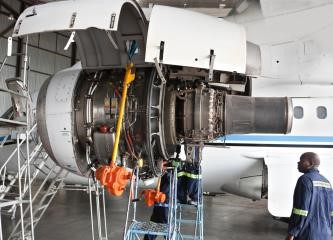An official website of the United States government
 United States Department of Labor
United States Department of Labor

Diagnose, adjust, repair, or overhaul aircraft engines and assemblies, such as hydraulic and pneumatic systems.
The qualifications that workers need to use judgment, make decisions, interact with others, and adapt to changes in jobs.
| Requirement | Yes | No |
|---|---|---|
|
Adaptability: Work schedule variability |
55.0 | 45.0 |
|
Pace: Pause control |
43.1 | 56.9 |
|
Working around crowds |
<0.5 | >99.5 |
|
Telework |
<0.5 | >99.5 |
|
Work review: Supervising others |
<10 | >90 |
|
Work review: Presence of supervisor |
58.9 | 41.1 |
|
Source: U.S. Bureau of Labor Statistics, Occupational Requirements Survey |
||
The minimum level of formal education required, credentials necessary, on-the-job training, and prior work experience necessary for average performance in jobs.
In 2024, on-the-job training was required for 66.0 percent of aircraft mechanics and service technicians.
A high school diploma was required for 91.1 percent of aircraft mechanics and service technicians.
The various tangible or concrete hazards or difficulties that are in the vicinity of where jobs’ critical tasks are performed.
In 2024, greater than 99.5 percent of aircraft mechanics and service technicians were not exposed to extreme cold, and greater than 70 percent were not exposed to extreme heat. Wetness was not present for 28.8 percent, greater than 95 percent were not exposed to heavy vibrations, and 9.8 percent were not exposed to the outdoors.
Refer to the physical activities required to perform tasks in jobs. The presence and, in some cases, duration of these activities are published.
In 2024, reaching at or below the shoulder was required for greater than 99.5 percent of aircraft mechanics and service technicians and was not required for less than 0.5 percent. For less than 25 percent of workers, reaching at or below the shoulder was seldom performed, for 78.2 percent reaching at or below the shoulder occurred occasionally, 13.4 percent frequently, and for less than 0.5 percent reaching at or below the shoulder occurred constantly.
Performing work in low postures was required for greater than 90 percent of aircraft mechanics and service technicians and was not required for less than 10 percent.
On average, aircraft mechanics and service technicians spent 28.3 percent of the workday sitting and 71.7 percent of the workday standing.
| Requirement | Yes | No |
|---|---|---|
|
Choice of sitting or standing |
<10 | >90 |
|
Driving |
53.6 | 46.4 |
|
Climbing structure-related ramps or stairs |
<5 | >95 |
|
Source: U.S. Bureau of Labor Statistics, Occupational Requirements Survey |
||